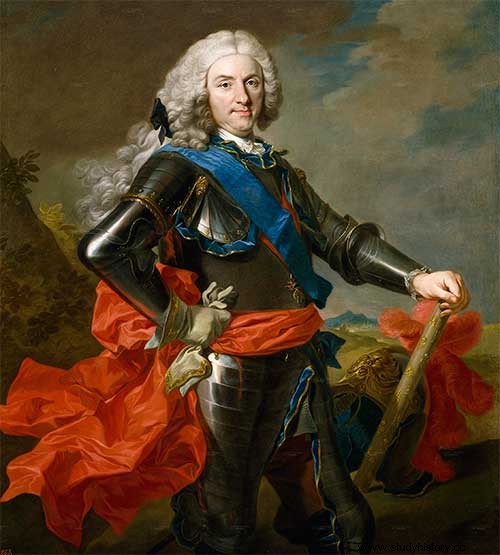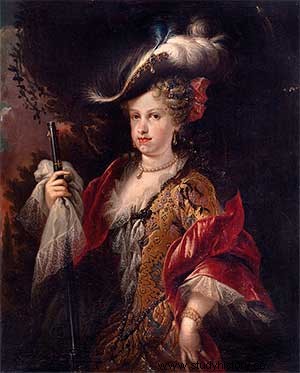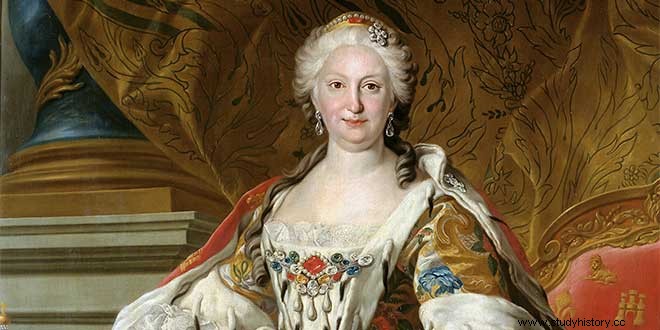Philip V was king of Spain , first of the French Bourbon dynasty, whose accession to the throne at the beginning of the 18th century opened a new historical period characterized by the administrative standardization of the State, which adopted the French centralist model, and the reorganization of the court and the financial system , also made according to the Gallic reference model.
Facts about Felipe V
1683 He is born in Versailles.
1700 Proclamation of Philip V as King of Spain.
1701 Wedding with Maria Luisa Gabriela of Savoy.
1714 Death of his first wife. Second marriage with Isabel Farnesio
1724 Second reign, after the death of his son Luis I.
1746 He died in Madrid.
Background to reign
In the last years of the reign of Charles II, Spain offered a pathetic spectacle of degradation . The fall of the Count of Oropesa, whose performance as prime minister between 1685 and 1691 had constituted the only hopeful parenthesis in the slow agony of Castile, increased the dramatic picture of misrule and made clear the urgency of a change that would mitigate the situation. It was then resorted to “divide and rule”, dividing the peninsula into three large administrative regions; but the singular experiment - nothing more and nothing less than a feudal partition between three rival lords - imposed on a State that already possessed the most rigid and complicated bureaucratic structure, only succeeded in provoking a new series of conflicts of jurisdiction. Internationally, the disastrous war against France, which lasted from 1689 to 1697, had become unsustainable . It ended in September of that year through the Treaty of Ryswick, thanks to the strategy of Louis XIV, since his ultimate goal was to ensure for the Bourbons the inheritance of an undivided Spain, and to achieve this he believed diplomacy was more prudent than arms. The problem of the succession was a reality, the most pressing of those that beset Carlos II. His marriage to María Luisa de Orleans, who died in 1689, had been sterile; It soon became clear that with his second wife, María Ana de Neoburgo, it would not bear fruit either. This fact precipitated the end of the already dying monarch . Unbalanced and affected by epileptic seizures, he became easy prey for courtiers, ecclesiastical representatives and foreign diplomats who convinced him that he was the victim of a spell. The court was invaded by visionary nuns, confessors and exorcists who used every method known to the Church to extirpate the evil spirit. Since then, the Spanish king would be Carlos II the bewitched, the last of the Habsburgs to occupy the throne of the peninsula. On his deathbed, after many negotiations and intrigues behind his back, on October 2, 1700 he appointed the Duke of Anjou as successor to all his domains . Nothing could make him revoke his decision in the thirty days that his life still lasted:the Enchanted One remained firm until his last breath, with a dignity and integrity that that unfortunate and deformed being had never shown in life. The Sun King, then, had gotten away with it:the throne of Spain would go to his grandson, Duke Felipe de Anjou.
The first reign of the first Bourbon
Second son of the great dauphin Luis and princess María Ana Cristina of Bavaria, grandson, then, of Luis XIV and great-grandson of Felipe IV of Spain, Felipe V was born on December 19, 1683 in Versailles . On his father's side he was a Bourbon, and judging from one of the earliest portraits of him painted by Joseph Vivien, he already showed in his teens the characteristic physical traits of the family; he too, like almost all of them, suffered from an exaggerated sexual appetite. His mother was a Wittelsbach. From her he inherited a kind of ankylosing melancholy that was manifested by long periods of seclusion and abandonment, and that over time would lead him to a pronounced dementia.

Proclamation of Felipe V
When on November 16, 1700, Louis XIV convened the court at the Palace of Versailles to announce the new sovereign, Philip of Anjou had not yet turned seventeen . According to certain chronicles, he received the news pleased and gleefully joked with his brothers, the Dukes of Burgundy and Berry, about his impending reign. But Sun King, who used to display the greatest solemnity on great occasions, continued his speech ceremoniously. Finally, turning to his grandson, he advised her: «Be a good Spaniard, but never forget that you were born in France» . Thus, two centuries after a representative of the House of Bourbon - the sixth son of Saint Louis Robert of Clermont - ascended the French throne for the first time, the Duke of Anjou became the first Bourbon to reign in Spain. And he would do it, at least in the first phase of his long tenure, on the advice of his grandfather and under his supervision.
The new king was proclaimed as Felipe V on November 24, recognized as a legitimate monarch by the European powers except Austria, since Archduke Carlos considered himself the heir with the most rights and also claimed the throne.
Arrival in Spain
At the end of January 1701 Philip V left for Spain and would never set foot on French soil again. In February he entered Irun and in April he arrived in Madrid. On May 8 he swore his high investiture in Jerónimos before the Castilians and the people welcomed the young monarch with hope, whose pleasant appearance and elegant bearing easily prevailed over the deformed figure of his predecessor . He even apologized that he did not speak a single word of Spanish, something that just a few decades before, when it was still the noble language everywhere, would have been inadmissible. As a first sign of that pleasure, he was invited to witness an auto-da-fe, but the king refused in horror. He came from a court that, in contrast to the Spanish, exuded refinement and was also more cheerful. The old distinction of the Castilian court, alien to the sumptuous taste of Louis XIV, was revealed, in the eyes of the young Felipe V, as a boring pacatería that confused seriousness with virtue and intrigue with fun. Implementing the French was almost easier than adapting, and the first fifteen years of his reign would act accordingly. assisted by a compact "embassy" of diplomats, soldiers, aristocrats and merchants sent by Louis XIV, headed by the famous princess of the Ursines.
The triple alliance for the Spanish crown

Spanish nobles grew indignant at seeing the country ruled by a clique following instructions from Versailles, and initial sympathy soon turned to suspicion. The Catalans were pioneers in showing this animosity:when in mid-1701 Philip V was on his way to Figueras to marry María Luisa Gabriela de Saboya, he presided over a court session in Barcelona in which he granted too many privileges. Such magnanimity created susceptibilities; on the other hand, the memory of the recent war with France and the absolutist and centralizing policy of the Sun King cemented Catalan skepticism. As for the European powers, they soon joined Austria in its struggle for the throne and in September of the same year the Triple Alliance was formed with England and Holland, which was later joined by Savoy —despite the fact that the Duke Savoyard was the father-in-law of Felipe V— and Portugal . A formidable coalition to fight Louis XIV and his only ally:Spain. All of which would not provide the first Bourbon with an easy government, much less peaceful.
Although the struggles began in the Hispanic possessions, they soon spread to the peninsula on different fronts, inaugurating the War of Succession . In 1702, Felipe V wanted to defend the Spanish dominions in person and went to Italy, achieving two triumphs in Santa Vittoria and Luzzara. It was during that first estrangement from his wife that his depressive crisis began to worsen. His natural propensity, added to sexual abstinence —the horror of sin prevented him from practicing extramarital affairs— produced such an uneasiness in him that he believed he was about to die. Even so, the King of Spain achieved some victories, the most important of which was that of Almansa in 1707, over the Anglo-Portuguese forces that had taken Madrid the previous year, a fact that earned the apathetic Philip V the nickname of the Cheerful.
End of the war for the Spanish crown
But the war would only begin to see an end from 1711, when on the death of Emperor Joseph I of Germany, his brother, Archduke Charles, took over the imperial throne. The allied countries, which until then had fought to prevent the aggrandizement of France, were uninterested in a contest that henceforth would lead only to the aggrandizement of Austria. The last gasps of the War of Succession were limited to Barcelona, Mallorca and Ibiza, which delayed their capitulation until 1715 . To crush Catalonia, Felipe V signed the peace treaty imposed by his enemies, thus dismembering the important Hispanic possessions in Europe. The house of Austria was granted Flanders, the Milanese, Naples and the presidios of Tuscany and Sardinia; to the House of Savoy, Sicily; to Portugal, the colony of Sacramento; and to England, Gibraltar and Menorca . In this regard, the treaties of Utrecht and Rastadt —of 1713 and 1714, respectively— were decisive. The war also propitiated a series of changes in the structuring of the State, with the establishment of the secretariats, from which the future ministries would arise; and in the administration, with the creation of the mayors, in 1711, and the adoption of the Salic law, which excluded women in the succession to the throne and in the distribution of land. These transformations culminated in the abolition of the autonomous regime of the kingdoms of the Crown of Aragon, mostly assimilated to Castile. Although his first reign lasted another ten years, the end of these initial lustrums marked the end of a defined period of his rule.
Women's weapons
Four children were born from Felipe V's marriage to María Luisa:Luis, Felipe —who died shortly after birth—, Felipe Pedro and Fernando. Two of them - the first and the last - would succeed his father on the throne. Still very young-she had married at the age of fourteen-, the queen herself died on February 14, 1714, coinciding with the throes of the War of Succession.
The sexual and psychological peculiarities of Felipe V were so well known in the diplomatic circuits that, as soon as his first wife died, the European chancelleries rushed to find him a second . At first the rumor spread that the successor would be the princess of the Ursinos, and when the king retired to the palace of the Duke of Medinaceli to mourn, it was even said that she settled in a nearby monastery equipped with an underground passageway that communicated with the estate, but the princess was more than half a century older than the king and was seventy-two years old at the time. Whatever it was, the woman who had so much influenced her rule thought she could continue to exercise that domain in a less sophisticated way. exposed if the king married a docile and inexperienced young woman. For this reason, she agreed to the suggestion of Count Alberoni, delegate of the Duke of Parma in Madrid, to arrange a marriage with the daughter of her lord, Isabel Farnesio, who, according to the count, had those characteristics. The princess did not suspect that in Alberoni she had a rival, and convinced of perpetuating her power, she contributed to the wedding taking place immediately. So, on September 16, 1714, the betrothal by proxy was celebrated in Parma and Isabel Farnesio set out for Madrid .
The new queen was, at twenty-one, a determined woman of character. This was evident as soon as she arrived, when even before being introduced to her husband, she had the princess of the Ursines thrown out —and later arrested. The king took sides with his wife, thereby initiating a new stage of his reign. From that moment on, Spain emancipated itself from French influence — on the other hand, Louis XIV would die a year later — and, through Isabel, channeled her actions through Italian channels . In foreign affairs, Felipe V always let himself be carried away by the women of his kingdom, and from 1715 the Madrid court oriented his designs on the immediate dynastic interests of Isabel.
This ambitious woman wanted to secure for her children — since the heirs to the Spanish crown were her stepchildren — the Italian dukedoms and kingdoms lost by the Treaty of Utrecht. A difficult undertaking and, above all, alien to the interests of the peninsula. However, the queen would achieve her goal and more than that- her eldest son Charles would be her king of Naples and of the Two Sicilies; Felipe, Duke of Parma and Plasencia; Luis Antonio, Archbishop of Toledo; Maria Teresa, queen of France, and Maria Victoria, queen of Portugal. Only María Antonia was going to remain single. Francisco, her second son had died in 1717, a few weeks after being born.

Abdication of Felipe V
Felipe V abdicated on January 10, 1724 in favor of his son Luis I, citing his desire to seclude himself in the palace of San Ildefonso -which he had built in the image of Versailles to meditate on his eternal salvation and live like an ascetic . It is possible to conjecture that this pretext was the public reason for a more intimate one:to seize the French crown. With the Duke of Orleans dead and the young Louis XV about to die without issue, all that remained was to wait for his death. But the one who died was his own son Luis, of smallpox, and Felipe V, against his will, returned to occupy the throne the same year of his abdication. It was at the beginning of his second reign that his psychotic symptoms intensified. At first, his proclivity to his apathy was apparent; later his extravagances were the talk of the whole world. Still, he reigned for another twenty years sleeping during the day and attending to government business at night. Forcing the court to second his insanity, he organized hunts at two in the morning and pretended to ride the horses of the palace tapestries. It is clear, then, that it was the queen who really ruled during this period characterized by a policy aimed above all at achieving and then securing the position of her children. This is proven by the Treaty of Seville of 1729 and the family pacts signed with France in 1733 and 1743. Thanks to them, first taking advantage of the Polish succession war, and then the Austrian one, her children acceded to the Italian thrones.
Philip V died suddenly on July 9, 1746, after a stroke . He ceased to exist in the arms of his wife, in the Buen Retiro Palace, without religious help. His body was taken by testamentary disposition to the royal site of San Ildefonso. His son Ferdinand VI would succeed him.
